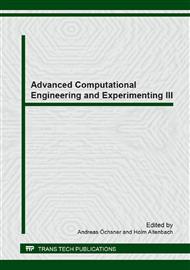p.5
p.11
p.15
p.21
p.31
p.37
p.43
p.49
p.55
On the Finite Element Modelling and Simulation of Carbon Nanotubes
Abstract:
In this paper, two different beam elements (i.e. according to the Bernoulli beam and Timoshenko beam theory) for the modeling of the behavior of carbon nanotubes are applied. Finite element models are developed for this study with variation of chirality for both zig-zag and armchair configurations of CNTs. The deformations from the finite element simulations are subsequently used to predict the elastic stiffness and the critical buckling load in terms of material and geometric parameters. Furthermore, the dependence of mechanical properties on the kind of beam element and the mesh density is also compared. Based on the obtained results, Youngs modulus and critical buckling load of structures using Timoshenko beams are clearly lower than the Bernoulli beam approach for all chiralities.
Info:
Periodical:
Pages:
55-61
Citation:
Online since:
April 2014
Authors:
Price:
Сopyright:
© 2014 Trans Tech Publications Ltd. All Rights Reserved
Share:
Citation:


